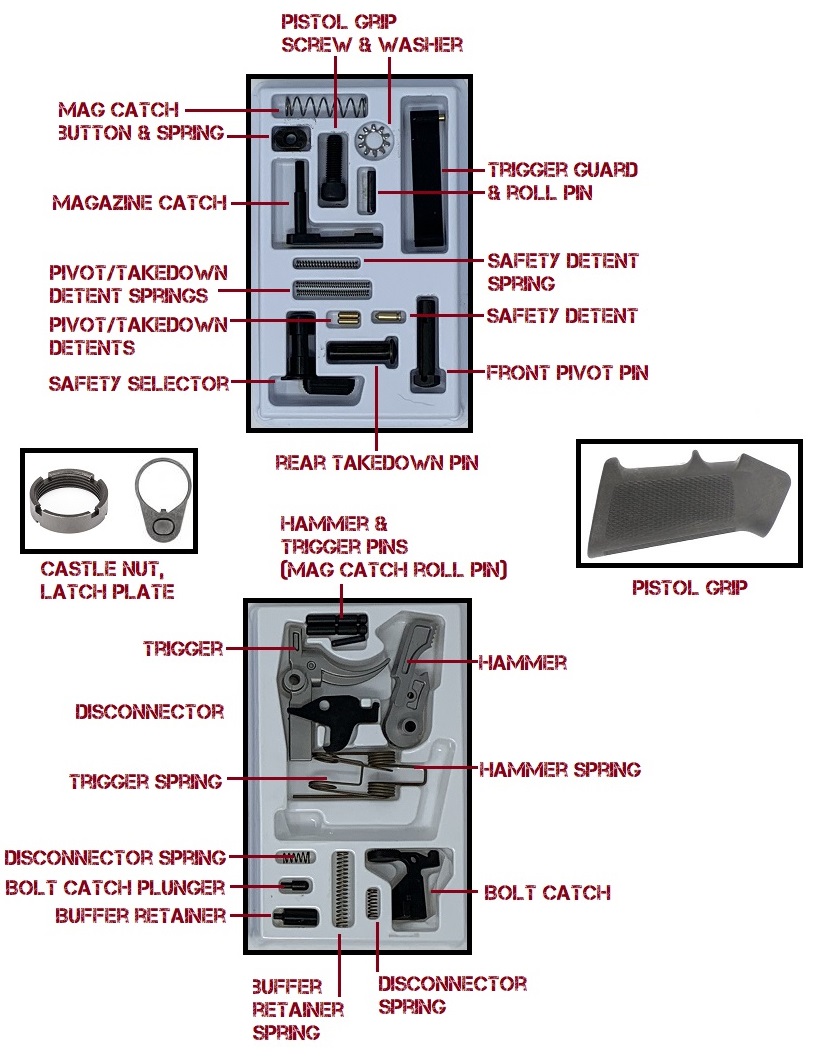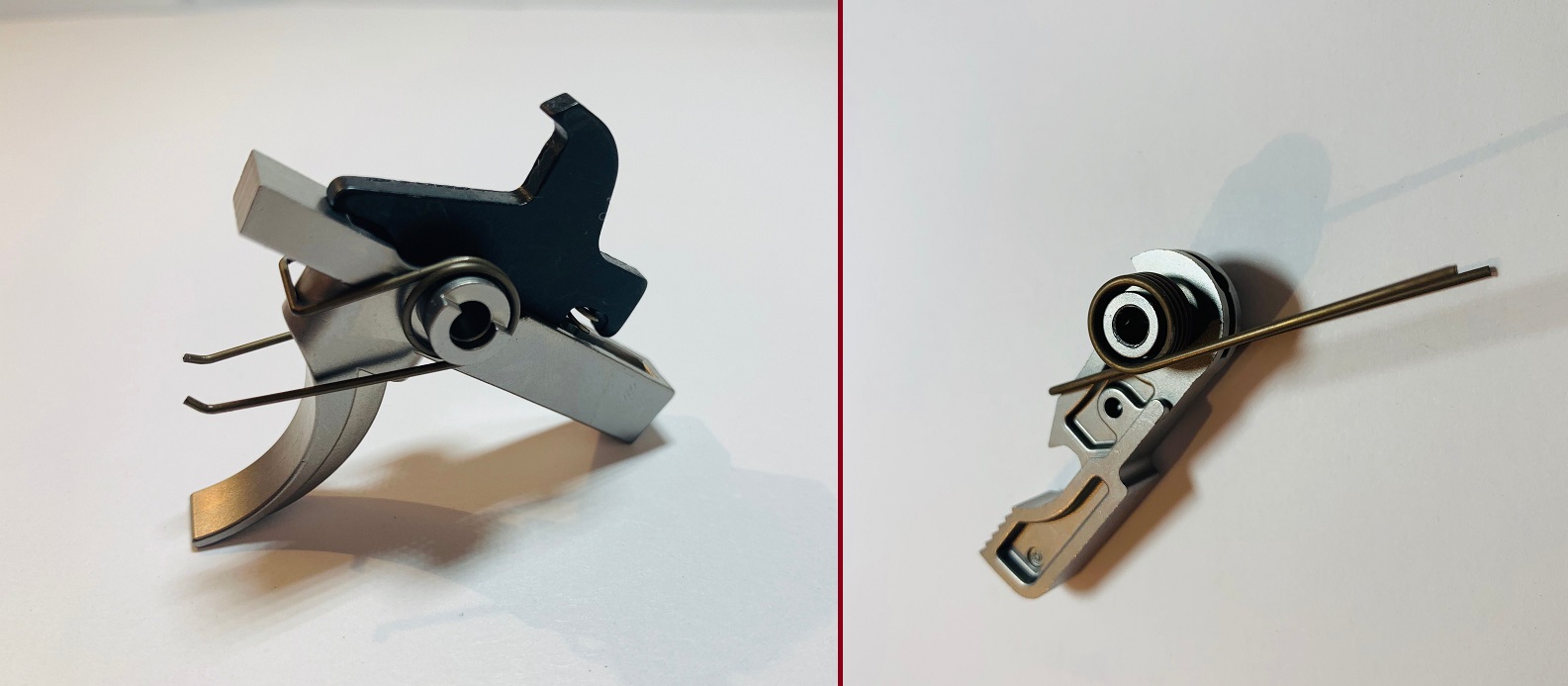AR-15 Lower Parts Kit Compatibility & FAQ
Posted by Gun Builders Depot on Feb 17th 2021
The most important part of assembling an AR-15 is the installation of the lower parts kit. Without it, you've got nothing more than an empty lower receiver, and a barreled upper assembly. You need to put the guts in your gun to make it run -- but what's the deal with all these LPKs? What's an M16 parts kit? Is it different from an AR-15 parts kit? What about those hammer hooks and disconnectors? We're explaining everything you need to know, to ensure you've got the right components to complete your AR-15's lower receiver (or finished 80% lower, since that's the better route to go, after all).
What's in a Lower Parts Kit?

Well, it's all that stuff you see above. These are the parts that go inside the stripped lower receiver to make it chamber and fire off live rounds when you squeeze the trigger. The big components of the parts kit comprise what's called the fire control group, or "FCG", shown assembled outside the receiver here.

The fire control group includes the:
- Hammer
- Hammer pin
- Hammer spring
- Trigger
- Trigger pin
- Trigger spring
- Disconnector
- Disconnector spring
- Safety lever (not pictured)
- Sear (built into trigger)
The FCG is only a third, or so, of the total equation. You also need to install components on the outside and rear of the lower receiver, such as the:
- Bolt catch assembly
- Magazine catch assembly
- Pistol grip
- Buffer tube
- Latch plate
- Castle nut

The buffer tube, latch plate, and castle nut do not typically come with lower parts kits. But they are required to secure both the buttstock (or pistol brace) and the safety lever by way of capturing a small pin (called a detent) and spring. Most parts kits come with a pistol grip with bolt and washer for securing the grip to the lower. This is not always the case, so double-check what components come with an LPK when ordering. There are loads of questions concerning LPKs and their compatibility and installation. Let's go over the most common questions.
FAQs
Q: What is a "mil-spec" AR-15 part skit?
A mil-spec parts kit is considered universal. It adheres (mostly) to the M16's and M4's original parts kit configuration. This means it utilizes a single-stage trigger with a pull weight of approximately 4.5 pounds. Importantly, a mil-spec parts kit is not a "military-issued" parts kit. This designation only indicates that the parts kit in question should fit in just about every AR-15 lower receiver on the market. It's considered the gold standard, if you will, for building a typical AR-15 rifle chambered in 5.56 NATO or .223 Remington.
Q: How is an M16 or "full-auto" parts kit different?
An M16 parts kit utilizes a hammer, trigger, disconnector, and safety with different hooks and shapes which, when combined with the appropriate M16 lower receiver and auto sear, allows for fully automatic fire. Unless you possess a special Federal Firearms License (FFL), configuring an AR-15 in this manner is both highly illegal and not at all recommended. An auto sear may be considered a machinegun by itself, and simply owning one alongside an AR-15 may be considered "constructive intent" by the ATF. For your sake, it's best to never own or otherwise possess an auto sear or M16 parts kit of any kind.
An M16 parts kit cannot be installed in an AR-15 lower receiver, anyway. AR-15 receivers are not physically fabricated to accepted these differently shaped fire control components. Even if your receiver was capable of accepting an M16 LPK, there would be no inherent benefit in installing such a parts kit. In fact, modern AR-15 parts kits tend to provide a better trigger action and shorter reset compared to these military-surplus units.
In short, don't do it.
Q: What parts kit do I need for an AR-10 or .308 AR?
The AR-10 cannot be built piece by piece, like an AR-15. The original ArmaLite rifles are typically only sold to military and law enforcement. Instead, DPMS Panther Arms produced the LR-308 to replace the AR-10 for the civilian market. The LR-308 can and often is built piece by piece, like an AR-15. Although the lower receiver is physically longer to accommodate the larger bolt carrier assembly and upper receiver, this .308 AR still uses an unmodified AR-15 lower parts kit, including the same pins, springs, mag catch, bolt catch, FCG parts, and detents.
Q: What LPK is required for an AR-9 lower?
The AR-9's receivers are based on the AR-15 platform, and thus it uses an AR-15 lower parts kit. There are just two differences, found in the ejector and the magazine catch and release. Since the AR-9 uses 9mm Glock magazines (and in the case of our 9mm 80% lower, a modified magazine well with a better fit and aesthetic) it must utilize a modified assembly to secure the magazine in the mag well. And since 9mm operates on blow-back and not direct-impingement or piston gas, it requires a modified ejector that is separate from the bolt, unlike the AR-15's typical 5.56/.223 bolt carrier assembly.
Q: What LPKs do both 6.5mm ARs use?
Conveniently, both 6.5mm AR configurations are based on the 5.56 and .308 platforms. The 6.5 Grendel is built on the AR-15 and uses a modified barrel and bolt head, with standard 5.56/.223 magazines. The same holds true for 6.5 Creedmoor, which is built on the LR-308 and also uses a modified barrel and high-pressure bolt carrier assembly, with typical .308 magazines. That means both 6.5 loads use a mil-spec AR-15 lower parts kit.
Q: What parts kit does 300 Blackout use?
If you guessed that it uses an AR-15 LPK like all the other ARs, you're correct. Like the Grendel cartridge, the 300 Blackout is built entirely on the AR-15's upper and lower receivers and only uses a different barrel, while retaining the use of 5.56 magazines. Although 300 BLK typically requires a shorter gas system and lighter buffer to operate reliably, this does not involve using any modified parts in the upper or lower receivers.
Q: How do I install an LPK?
The steps remain virtually identical for all lower receivers, save for the 9mm lower, which only requires a slightly different install for the magazine catch and ejector.
We wrote a nice, in-depth guide with pictures that walks you through every step. We also cover the tools required and we provide some tips for making the job as easy as possible. You'll need about an hour to get the job done.
Q: What's a drop-in trigger? How does it work?
A drop-in trigger (like the LE145) does exactly what the name implies: It literally drops into your receiver, which already has a mil-spec lower parts kit installed. These triggers provide shorter resets, lighter pull weights, and generally better performance. You must first remove the hammer and trigger pins, and remove the original hammer, trigger, and disconnector.
You'll keep your safety lever and its functionality without modification. In fact, no other modifications are required: Simply drop the trigger in place, and either reuse your factory trigger and hammer pins, or use the pins your new trigger might come with. Then you can get back to shooting. Drop-in units can provide adjustability, single- or double-stage function, or binary fire, which release the hammer on the trigger pull and release for rapid-fire function.
Recap
We hit a lot of technical info, so here's the important stuff distilled into a few bullets:
- A mil-spec AR-15 lower parts kit is the gold standard found in almost all AR-15s.
- Every AR-type rifle or pistol uses an AR-15 lower parts kit, including 9mm and .308.
- Installing an M16 parts kit is never recommended. Especially if it includes an auto sear.
- Owning an auto sear and M16 parts kit with an AR-15 could land you in legal hot water.
- Any AR-15 can be upgraded by swapping the factory hammer and trigger for a drop-in unit.
DISCLAIMER: If you are new to the world of DIY gun building, you likely have a lot of questions and rightfully so. It’s an area that has a lot of questions that, without the correct answers, could have some serious implications. At GunBuilders.com, we are by no means providing this content on our website to serve as legal advice or legal counsel. We encourage each and every builder to perform their own research around their respective State laws as well as educating themselves on the Federal laws. When performing your own research, please be sure that you are getting your information from a reliable source.

